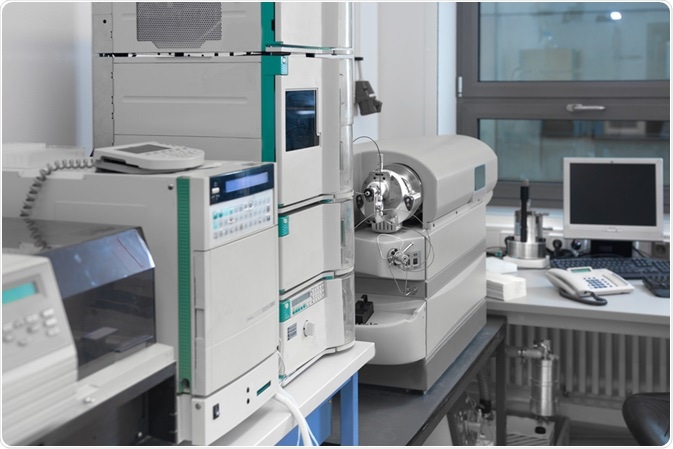Home » Health News »
Analyzing Complex Samples with Supercritical Fluid Chromatography-Mass Spectrometry
Within the field of separation science, researchers have become increasingly interested in chromatographic techniques that are capable of improving the sensitivity, resolution, and speed of their complex sample analyses.

Image Credit: Anyaivanova/Shutterstock.com
To this end, recent improvements in supercritical fluid chromatography (SFC) technology has allowed researchers to reconsider this analytical technique for the analysis of complex samples.
Analyzing complex samples
Any plant, biological, petrochemical or environmental sample can be considered to be a complex sample. By definition, a complex sample is a multicomponent sample that contains a wide variety of compounds and therefore does not exhibit a precise composition.
The analysis of complex samples is therefore difficult, as the analytes of interest within these samples are often present at low concentrations.
Currently, complex samples can be analyzed by either targeted analysis or non-targeted analysis techniques. Whereas targeted analysis is only capable of analyzing the concentration of selected specific compounds, the non-targeted analysis incorporates whole sample profiling to identify metabolites, degradation products and contaminants that may be present within a given sample. Some of the most common analytical techniques that can be used for the analysis of complex samples include liquid chromatography (LC) that is coupled with high-performance liquid chromatography (HPLC), ultra-high performance liquid chromatography (UHPLC), gas chromatography (GC) or capillary electrophoresis, each of which are often combined with mass spectrometry (MS) detection.
What is supercritical fluid chromatography?
When supercritical fluid chromatography (SFC) was first reported in the early 1960s, it was originally referred to as high-pressure gas chromatography (HPGC).
During its initial introduction into the science world, SFC was noted for its ability to separate both thermally unstable and large molecular weight compounds at a superior rate as compared to what was allowable by conventional GC technologies at the time.
While earlier SFC technologies utilized a wide range of mobile phases including nitrous oxide, hydrocarbons, chlorofluorocarbons and carbon dioxide (CO2), CO2 remains the primary mobile phase used for modern SFC purposes as a result of its low toxicity and flammability properties.
When combined with mass spectrometry (MS), SFC-MS can be further enhanced by incorporating several different features, such as various atmospheric pressure ionization (API) interfaces.
Additional advantageous features associated with SFC-MS include the complete elimination of both derivatization and the use of organic solvent extract evaporation processes.
Furthermore, SFC-MS columns are packed with sub-2 micrometer particles, thereby indicating a high-resolution and robustness of this specific technique.
SFC-MS analysis of complex samples
After the first commercial SFC-MS systems were introduced into the marketplace, the applications of this technology for the analysis of complex samples skyrocketed.
More specifically, SFC-MS has been used to analyze and quantify contaminants and other complex compounds for agricultural, petrochemical, environmental and bioanalytical purposes. As researchers around the world become more aware of the numerous advantages associated with the SFC-MS method, this technique will inevitably be applied to many other industries soon.
Bioanalysis
Bioanalysis often requires researchers to perform a highly specific quantitative analysis of various xenobiotic, endogenous and metabolic compounds present in a wide range of sample types including whole blood, plasma, serum, saliva, urine, feces, hair and much more.
In addition to being a primary technique for lipidomic analytical studies, SFC-MS has also been used to analyze fat-soluble vitamins, tocopherols, and carotenoids, as well as peptides and amino acids.
Food analysis
Within the food industry, for example, SFC-MS has replaced traditional orthogonal GC and LC approaches for the separation and analysis of food lipids.
When used for this purpose, SFC-MS provides important information on the concentrations of hydrophobic triacylglycerols (TAG), diacylglycerols and free fatty acids (FFAs) that are present in vegetable oils, berries, fish oil, and milk, which allows researchers to confirm or reject the authenticity and nutritional value of these products.
Environmental analysis
The global rise in pollution continues to threaten the homeostasis of our environment. SFC and SFC-MS have been widely used to determine the concentrations of environmental contaminants like pesticides, pharmaceutical agents, industrial additives and other potentially harmful compounds present within the environment, particularly when present at low and trace levels.
SFC has already been applied for the analysis of a wide range of different contaminants present in the rain, river water, wastewater, and soil.
Sources
- Pilarova, V., Plachka, K., Khalikova, M. A., Svec, F., & Novakova, L. (2019). Recent developments in supercritical fluid chromatography-mass spectrometry: Is it a viable option for analysis of complex samples? TrAC Trends in Analytical chemistry 112; 212-225. DOI: 10.1016/j.trac.2018.12.023.
Further Reading
- All Chromatography Content
- Chromatography Overview
- Gas Chromatography-Mass Spectrometry (GC-MS) Applications
- High Performance Liquid Chromatography (HPLC)
- Liquid Chromatography-Mass Spectrometry (LC-MS) Applications
Last Updated: Feb 7, 2020

Written by
Benedette Cuffari
After completing her Bachelor of Science in Toxicology with two minors in Spanish and Chemistry in 2016, Benedette continued her studies to complete her Master of Science in Toxicology in May of 2018.During graduate school, Benedette investigated the dermatotoxicity of mechlorethamine and bendamustine, which are two nitrogen mustard alkylating agents that are currently used in anticancer therapy.
Source: Read Full Article



